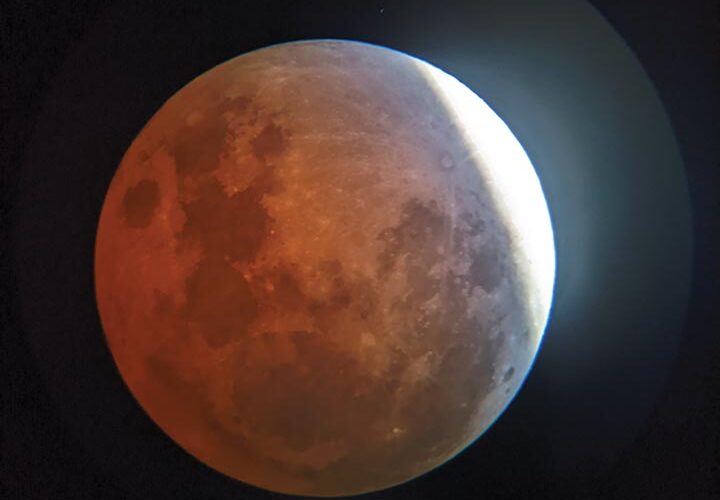Lasting almost three and a half hours, the longest partial eclipse in 580 years drew students to Foggy Bottom Observatory on Nov. 19, 2021. At 4:26 a.m., astronomy-physics major Riley Corcoran ’22 — who organized the gathering — took this shot as the moon was just past its 98% totality.
Corcoran explains: “The bright white strip to the right shows the percentage that was not blocked by the Earth’s shadow. The rest of the moon appears red during a lunar eclipse because of the way sunlight bends through Earth’s atmosphere. No direct sunlight is reaching the moon during an eclipse, but the molecules within our atmosphere will bend and refract the red light within the sunlight hitting the edges of Earth tangentially so that the red light meets up again somewhere behind Earth, lighting the moon red when it is in Earth’s shadow. More importantly, passing the sunlight through such a long tangential stretch of Earth’s atmosphere also helps filter out some of the other colors through the same scattering process; then only the red is left when the light exits the back of Earth to be bent toward the moon.”
This phenomenon similarly explains why sunsets and sunrises are red, she adds. “Sunlight travels through a longer stretch of atmosphere when the sun is close to the horizon, allowing all of the higher energy colors (red is the lowest energy color) to be scattered off, leaving only red left in the sky.”
“Word spread, and I ended up having at least 40 people come … some from the class, some from the Star ’Gate club, and others who came because they heard it was happening.”
Riley Corcoran ’22
Corcoran has been gaining experience using the observatory telescope since last summer when she conducted research with Professor Tom Balonek. They received a NASA New York Space Grant to study quasars. In the fall, she worked as an assistant, opening the observatory on clear nights to allow Astronomy 101 students to use the telescope.
A few days before the eclipse, Corcoran saw that the forecast was predicted to be clear and sent out an invitation to students. “Word spread, and I ended up having at least 40 people come … some from the class, some from the Star ’Gate club, and others who came because they heard it was happening.”
She took the photo using her Google Pixel phone, lining it up with the eyepiece. “It’s very close to what it would look like through the telescope,” Corcoran says. “The image represents about 30 arcminutes, or half a degree, of the sky.”

